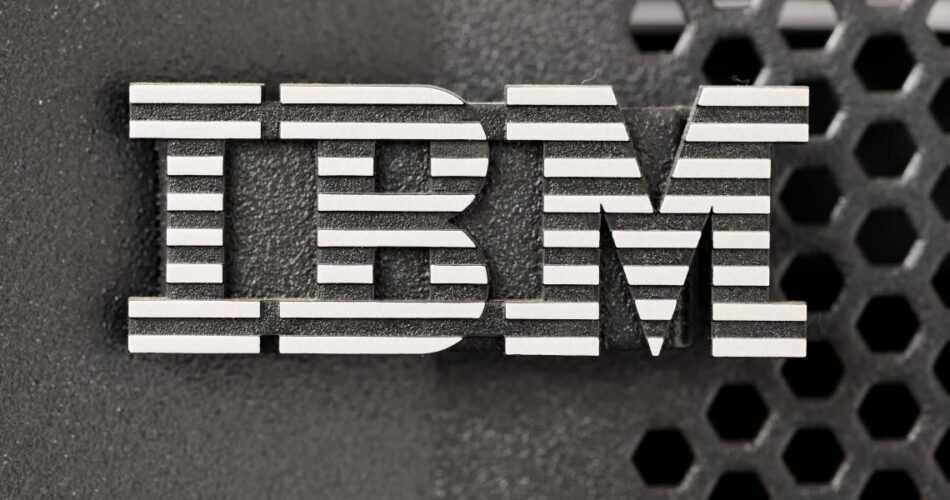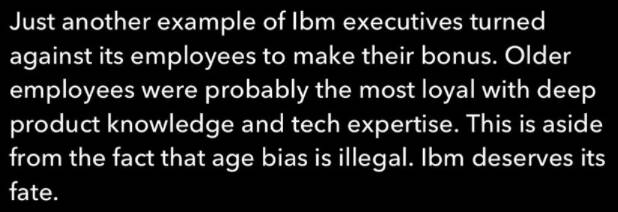Analysis IBM’s Chief Human Resources Officer Nickle LaMoreaux on Sunday rejected what she described as “false claims of age discrimination at the company.”
“Discrimination of any kind is entirely against our culture and who we are at IBM, and there was (and is) no systemic age discrimination at our company,” said LaMoreaux in a public statement posted to the company’s website.
The media reports she references follow from the release of documents in an age discrimination lawsuit against the venerable computing biz, Lohnn v. IBM. The initial complaint was filed in July 2021 [PDF] on behalf of Jorgen Lohnn, who took his own life after being laid off from the company.
“Jorgen Lohnn worked for IBM for approximately 15 years until his layoff in 2016 at the age of 57,” the initial complaint says. “He worked for IBM as a Client Executive for Sales and Distribution. He committed suicide after his layoff from IBM.
“Plaintiff [Denise Lohnn] contends that her husband, Mr Lohnn, fell victim to a years-long companywide discriminatory scheme implemented by IBM’s top management to build a younger workforce, by reducing its population of older workers in order to make room for the hiring of younger workers.”
The filing goes on to cite the Equal Employment Opportunity Commission (EEOC)’s August 31, 2020 letter, which noted that the EEOC – after a multi year investigation – had uncovered “top-down messaging from IBM’s highest ranks directing managers to engage in an aggressive approach to significantly reduce the headcount of older workers to make room for Early Professional Hires.”
IBM’s own employees are skeptical. The Register has heard from two sources that LaMoreaux’s missive has been criticized on Fishbowl, the company’s discussion forum. And we’ve seen screenshots to that effect.
Asked about this, an IBM spokesperson said, “We aren’t going to comment on what our employees are saying internally. IBM encourages open and honest dialogue with employees.”
More legal ammunition
Those involved in litigation against IBM have also expressed skepticism of LaMoreaux’s assertions.
“I’m not sure how IBM’s Human Resources Director can make these statements,” said Steven Cahn from New Jersey-based law firm Cahn & Parra, in an email to The Register. “I doubt she has seen the mountain of evidence that lawyers around the country have been accumulating.” Cahn is representing plaintiff Eugen Schenfeld in an age discrimination case against IBM.
Hundreds of former IBM employees are currently suing the IT giant based on age discrimination claims; the pool of potential plaintiffs is said to be around 13,000. The Register has written about several of these cases, including Schenfeld v. IBM, Kinney v. IBM, Rusis v. IBM, and Langley v. IBM, among others. And that’s to say nothing of recent race and gender-based discrimination cases IBM has settled.
The Langley case, as The Register understands, was quietly settled after the judge refused to dismiss the case and the plaintiffs were granted access to former CEO Ginni Rometty’s emails.
Asked how IBM describes cases it has settled, given LaMoreaux’s claim that the company has not discriminated, an IBM spokesperson replied, “IBM has never conceded to liability in any of the prior age settlements.”
Among the Big Blue employees discussing the LaMoreaux post and the Lohnn case, one suggested IBM is likely to settle any claim that makes it to trial for fear a guilty verdict would limit the company’s ability to get government contracts.
United States’ Executive Order 11246 “prohibits federal contractors from discriminating on the basis of race, color, religion, sex, sexual orientation, gender identity, or national origin.” So a conviction could put IBM’s government deals in jeopardy.
Also, The Register understands that the US Justice Department has the option to join an ongoing case against IBM. If that happened and the government prevailed, the DoJ could seek sanctions that included a ban on government contracts. However, the Feds have not publicly discussed any such plans, so that possibility remains purely speculative.
Dissing the dinobabes
Among the evidence to have emerged in the Lohnn case is that an unidentified IBMer – a former IBM executive, we’re told – applauded the use of the disparaging term “dinobabies” to refer to older employees and described his intention to make them “extinct.”
LaMoreaux in her statement insisted “that disrespectful language is not who we are” and maintained, “It in no way reflects IBM’s practices or policies.”
The filing last week represents an attempt by Lohnn’s attorney, Shannon Liss-Riordan, to have the judge void a provision of IBM’s arbitration agreement with Lohnn that prevents “piggybacking” on an existing age discrimination class action against IBM and a confidentiality provision that IBM has allegedly used to prevent arbitration cases from sharing evidence.
“[A] number of former employees have pursued ADEA [Age Discrimination in Employement Act] claims against IBM in arbitration and have amassed a great deal of highly relevant, incriminating, and indeed shocking evidence, showing the extent of IBM’s systemic plan to force out older workers and increase the proportion of younger ‘millennial’ workers, in order to build a young workforce, which IBM leaders believed would help it better compete against its newer, younger, hipper competitors, such as Google, Facebook, and Amazon,” the plaintiff’s motion for summary judgement says.
“However, IBM has wielded its confidentiality provision in its arbitration agreement aggressively to block these employees at every turn from using this highly relevant and damning evidence in each other’s cases.”
LaMoreaux cited company data from the period between 2010 and 2020 in an effort to demonstrate there has been no age discrimination at IBM. She said, “37 percent of all US hires at IBM were over the age of 40” during this period, and “IBM hired more than 10,000 people in the US over the age of 50 and 1,500 over the age of 60.”
Most of the lawsuits The Register is aware of concern the years 2016, 2017, and 2018, and the EEOC determination covers the years 2013 through 2018, so averaging in data from prior years may produce results that reflect more favorably on IBM. What’s more, stating that IBM hired 10,000 people in America over 50 and 1,500 from 2010 through 2020 can’t be interpreted without knowing how many people were hired in the US overall in that period. According to the EEOC, more than 85 per cent of the potential pool of people IBM considered for layoffs were older workers.
The Register asked IBM if it could provide the percentage of US employees laid off in 2016, 2017, and 2018 who were over 40 and over 50, as well as the total number of US employees laid off in each of those years. Big Blue’s spokesperson did not respond to those specific requests.
IBM in 2019 was sued for allegedly violating the Older Workers Benefit Protection Act (OWBPA) and the ADEA. The lawsuit, filed by Cohen Milstein Sellers & Toll PLLC, alleges among other things that IBM in 2014 stopped providing age-specific, demographic information about laid-off workers, as required by the OWBPA.
We asked how IBM reconciles the EEOC’s determination that there was systematic age discrimination at IBM with the company’s claim to the contrary. “The EEOC did not proceed to court, instead administratively closing the matter,” an IBM spokesperson responded.
For those challenging IBM in court, the matter remains open. ®
Source link






